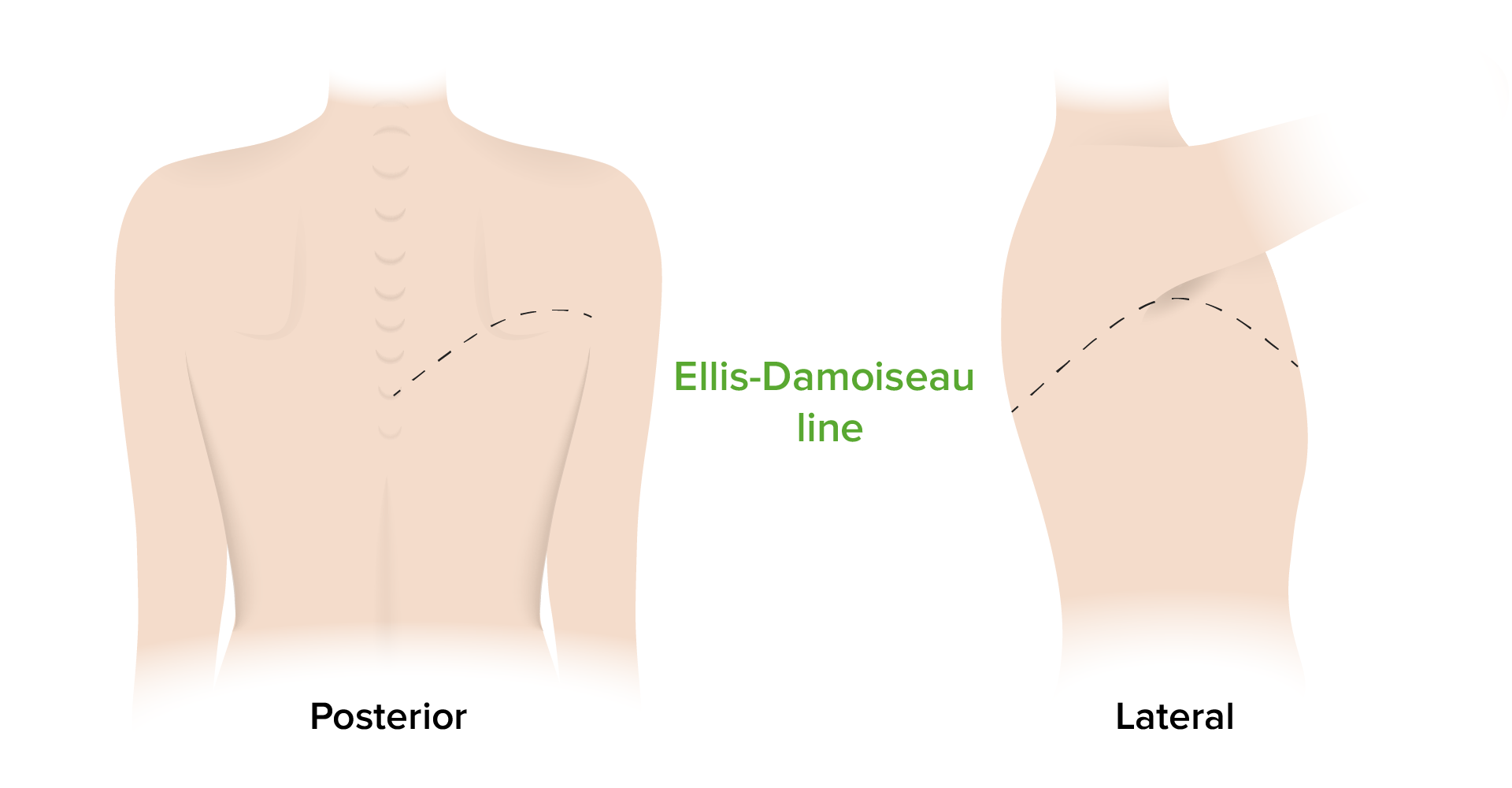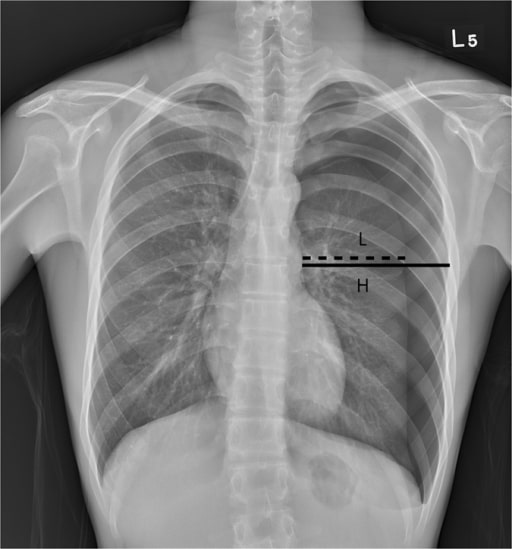Playlist
Show Playlist
Hide Playlist
Pneumothorax & Pleural Effusion: Pneumothorax
-
Slides SpecificDiseases RespiratoryPathology V2.pdf
-
Reference List Pathology.pdf
-
Download Lecture Overview
00:01 You're gonna love this lecture series because a number of issues that we'll go through here in which students tend to get confused, but it's about organization and making sure that you stick to the foundation of effusions, pneumothorax and OSA is obstructive sleep apnea. 00:20 And the different derivatives that you wanna keep in mind, as we walk through the diseases. 00:25 First, our topic takes us through pneumothorax. 00:29 So guess what you are accumulating within your pleural cavity? Accumulation of air in the pleural space. 00:35 What does it do? Resulting unilateral chest wall expansion. 00:40 So, what we'll do here is that we will walk through both sides along, what may then happen, as a result of different type of pneumothoraces and remember this is a specialty in which you could spend days upon, okay? So, what you're -- what we are covering is the absolute fundamental not too much and not too little exactly what you need, so that as reading a clinical vignette, you know what's going on with your patient and you're able to identify them rather quickly. 01:11 Okay, now patient presents with unilateral chest pain, dysnea, decreased tactile fremitus, hyper-resonance, meaning -- what does that mean? Upon percussion -- tympanic, diminished breath sounds, all on the affected side -- affected side. 01:31 Let's start there with our basic definition of pneumothorax. 01:36 Accumulation of air. Now, we'll go through specific types where primary, so here for the most part, we don't know what all is causing. 01:46 It could be a gene, folliculin, is now the type of gene that is often recognized as being the gene, folliculin, and due to rupture of apical subpleural bleb or cysts. 01:59 So now, imagine you're tall, thin, young male, who is now susceptible. 02:06 That's your risk factor patient and what ends up happening at the apex of the lung. 02:11 So pleural, a bleb -- what's a bleb mean? Good, kinda like a herniation and this may then rupture, so when it ruptures, what is it going to do? Wow, it's going to induce positive pressure and you tell me in order for the lung to expand, what that pleural pressure doing? Negative. It goes from negative and it goes to more negative and that means the lung will expand, remember that physiologically, right? So all of the sudden if it ruptures anything outside the pleural pressure cavity is going to be positive, are we okay with that? So therefore if you introduce positive pressure into the pleural cavity, I am -- it's gone, what's gone? The lung is going to be gone. It'll collapse. 02:54 Okay. Now, primary is where we are. This is spontaneous. 03:00 More or less a tall, thin, young male. 03:03 There is no secondary cause, is that clear? And it could be a genetic issue and that's as I said a gene that sometimes referred to as being folliculin. 03:12 Listen to what I'm saying, folliculin, secondary spontaneous, what does this mean? It's a secondary bullae from an emphysema. 03:21 What does that mean? Some go as far as causing or calling emphysema -- remember when we talked about emphysema, we talked about centrilobular? And if it's centrilobular, you're thinking about more about your proximal portion that affected and then you had your emphysema. Everyone's hear about what's known as bullous emphysema. 03:40 Well, for our purposes as the lung gets bigger and bigger and bigger, and emphysema at some point, you think you're gonna form bullae, sure you are. 03:51 And what do you think the bullae might do? Just like in primary, but this bullae is being formed by emphysema thinning, increase compliance, right, loss of elastic tissue, rupture. 04:05 Welcome to secondary spontaneous pneumothorax. 04:09 Once you get that down take a look at the other secondary causes including infection, mechanical ventilation, with the use of high pressure such as barotrauma. 04:19 Think about that. 04:20 Remember once again normally should be negative pressure that increases sizes of a volume of the lung. 04:26 However, if you introduce positive pressure, positive pressure, positive pressure, especially with the increased. Let's say a peep, right or -- let's say -- remember there was something called auto-PEEP that we talked about where upon expiration there tend to be more and more and more and more air that's left, and eventually what may then happen, secondary spontaneous type of pneumothorax. 04:47 And so therefore, it may result in "barotrauma." Open traumatic, what's happening here? Cause by blunt injury, rib fracture, penetrating gunshot wound. 04:57 Now, here once again part of secondary. So, you get shot by a gun, what happens? Now, it's going through the chest cavity, put a hole into the pleural cavity, introducing air, and what kind of pressure is this? Zero, even if you call it zero, okay, for example for all intent and purposes in medicine, if in sea level, it's 760, but we'll go ahead and call that zero, and oftentimes that is what it's referred to as -- and that's definitely a lot more positive and the atmosphere then it would be negative inside the pleural cavity. 05:31 So therefore secondary spontaneous pneumothorax or open type of pneumothorax. 05:36 The open type presents with shifting in the mediastinum to the injured side. 05:41 Listen, if the open type meaning to say, there's an open hole, that's communicating to the outside world, now, you've introduced positive pressure. 05:52 Where's my lung go? Collapses. 05:55 Next, what is it going to take with it? Oh, the mediastinum. Come on with me, right? So it's gonna pull the mediastinum, to the injured side that must be understood, spend a little bit of time here understanding primary tall, thin, young, look for that patient. 06:11 Secondary, look for some kind of disease process such as emphysema resulting a large bullae and rupture and then we have open traumatic in which you have then shifting of the mediastinum to the injured side. That's huge. 06:25 Next, let's all move on to tension, the opposite of open. What does that mean? Well, Dr. Raj, how can I possibly get air into the pleural cavity if it's not open? Well, this condition of tension pneumothorax, you only have opening when there's inspiration. 06:48 Let's say that you have a flap of your parenchyma. Okay, so here's my flap. 06:52 I breathe in -- okay, this thing opens. 06:57 What is this? The parenchyma opens and be on my -- hand right here, is the pleural cavity. 07:02 There's no pleural cavity and there's my -- there's my parenchyma, the lung. 07:07 And so now what has happened is that there's a little bit of a tear, the kind of behaves like a valve. 07:12 So by this I want you to think of a football, and as you put air into a football air does not come back out. 07:20 What are you creating inside a football? Tension, the pleural cavity is the football. 07:26 So now you have the tissue which behaves like the valve upon inspiration when what happens, good, the lung will expands and so therefore this flap opens and there goes my air into pleural cavity. 07:40 Upon expiration, flap closes. So where's my air trapped? Ah, in the pneumothorax, so what are you developing? Tension, tension, tension, tension, clear? Okay, so showcasing a ball and valve type of mechanism at which point upon expiration air gets further trapped? How does it get in there? Doing inspiration. 08:00 Next, so upon -- in the last discussion with open type of pneumothorax such as a gunshot wound. 08:08 Then, there was a collapse of the lung, and what happened to mediastinum? Move towards the side, right? And tension, what are you gonna do? Obviously, you're gonna shift the mediastinum to the opposite side. Take a look. 08:21 Okay, there's an emergency type of situation requiring immediate decompression and chest tube placement. 08:26 No joke. Tension. As simple, a simple pneumothorax accumulation of air in the pleural space slightly less sub-atmospheric than that of the other side. 08:38 Look at what that says. What is atmospheric pressure? I just told you at sea level in case you missed it. Here it is, one more time. 08:47 At sea level your pressure is 760 millimeters of mercury. 08:51 And that is your atmosphere. You take that 760 which is ground zero or control and you call that atmospheric pressure, zero, do that for me clinically. 09:00 A simple pneumothorax is one in which you're going to start increasing the pressure the pleural pressure meaning it will become more positive, but it will be slightly sub-atmospheric than that of the other side. 09:16 So meaning to say that it'll be more positive than the other side but it will still be sub-atmospheric. 09:23 That's it, that simple. Any grave issues right here? No. 09:27 Your grave consequences and sequelae will be coming from the tension. 09:31 You wanna know primary, the secondary spontaneous, you wanna know about the open and as to how that causes movement of your mediastinum to the side of the lesion. 09:43 Let's continue.
About the Lecture
The lecture Pneumothorax & Pleural Effusion: Pneumothorax by Carlo Raj, MD is from the course Disorders of the Pulmonary Circulation and the Respiratory Regulation: Basic Principles with Carlo Raj.
Included Quiz Questions
Which of the following would best describe a pneumothorax?
- Accumulation of air between the visceral and parietal pleura of the lung
- Alveolar collapse with reduced or absent gas exchange
- Accumulation of air or fluid in the pericardial cavity
- Fluid accumulation between the visceral and parietal pleura of the lung
- Accumulation of free air or gas in the mediastinum
Which of the following would be the most likely to develop primary spontaneous pneumothorax?
- Tall, thin, young male
- Obese female in her 5th decade of life
- Young adult with delayed puberty
- Short-statured female with webbed neck
- Excessive alcohol use in male or female
Which of the following is characteristic of open pneumothorax?
- The shift of the mediastinum to the injured side
- Hypertension
- Expansion of the lung parenchyma on the injured side
- Increased vital capacity
- Contralateral deviation of the mediastinum
What is the first step in the management of a patient with suspected tension pneumothorax?
- Emergent thoracocentesis
- Pulmonary function testing
- CT scan
- CXR
- Intubation
Customer reviews
5,0 of 5 stars
| 5 Stars |
|
5 |
| 4 Stars |
|
0 |
| 3 Stars |
|
0 |
| 2 Stars |
|
0 |
| 1 Star |
|
0 |







